Experimental Study on Propagation Characteristics of Kerosene/Air RDE with Different Diameters
Abstract
:1. Introduction
2. Experimental Facility and Methodology
2.1. Experimental Facility
2.2. Time Sequence
3. Results and Discussion
3.1. Analysis of Detonation Wave Propagation Mode and Spatial Instability
3.2. Analysis of Detonation Wave Propagation Velocity and Temporal Instability
3.3. Comparative Analysis of Propulsion Performance of RDEs with Different Diameters
4. Conclusions
- (1)
- In the large-scale RDE, the uneven detonation combustion along the annular combustor was discovered. Due to the uneven distribution of fuel supply pressure, there is a strong detonation wave and a weak detonation wave propagating in opposite direction, while in the small-scale RDE, there are two strong counter detonation waves with almost the same intensity.
- (2)
- Higher detonation wave velocity can be obtained in the large-scale RDE compared with that in small-scale RDE due to the longer reactant injection recovery time. However, the larger RDE usually has a smaller detonation range of equivalence ratio. Especially in the fuel-rich equivalence ratio, there often exists transition from detonation combustion to deflagration combustion.
- (3)
- Due to the limited effective thrust region generated by the detonation wave, a small-scale engine often has a higher specific thrust performance and higher specific impulse performance in the same two counter detonation waves system.
Author Contributions
Funding
Institutional Review Board Statement
Informed Consent Statement
Data Availability Statement
Conflicts of Interest
References
- Frolov, S.M.; Aksenov, V.S.; Ivanov, V.S.; Shamshin, I.O. Large-scale hydrogen–air continuous detonation combustor. Int. J. Hydrogen Energy 2015, 40, 1616–1623. [Google Scholar] [CrossRef]
- Heiser, W.H.; Pratt, D.T. Thermodynamic cycle analysis of pulse detonation engines. J. Propuls. Power 2002, 18, 68–76. [Google Scholar] [CrossRef]
- Muraleetharan, K.; Polanka, M.D.; Schauer, F.R.; Huff, R. Detonation Confinement using a Flat Channel Plate in a Radial Rotating Detonation Engine. In Proceedings of the AIAA Scitech 2020 Forum, Orlando, FL, USA, 6–10 January 2020. [Google Scholar]
- Wang, Y.; Wang, J.; Li, Y.S.; Li, Y. Induction for multiple rotating detonation waves in the hydrogen—oxygen mixture with tangential flow. Int. J. Hydrogen Energy 2014, 39, 11792–11797. [Google Scholar] [CrossRef]
- Bykovskii, F.A.; Zhdan, S.A.; Vedernikov, E.F. Realization and modeling of continuous spin detonation of a hydrogen-oxygen mixture in flow-type combustors. 2. Combustors with expansion of the annular channel. Combust. Explos. Shock Waves 2009, 45, 716–728. [Google Scholar] [CrossRef]
- Anand, V.; St. George, A.; Driscoll, R.; Gutmark, E. Experimental investigation of H2-air mixtures in a rotating detonation combustor. In Proceedings of the Turbo Expo: Power for Land, Sea, and Air, Montreal, QC, Canada, 15–19 June 2015; American Society of Mechanical Engineers: New York, NY, USA, 2015; Volume 56697. [Google Scholar]
- Wu, Y.; Zheng, Q.; Weng, C. An experimental study on the detonation transmission behaviours in acetylene-oxygen-argon mixtures. Energy 2018, 143, 554–561. [Google Scholar] [CrossRef]
- Bykovskii, F.A.; Vedernikov, E.F. Continuous detonation of a subsonic flow of a propellant. Combust. Explos. Shock Waves 2003, 39, 323–334. [Google Scholar] [CrossRef]
- Anand, V.; George, A.S.; de Luzan, C.F.; Gutmark, E. Rotating detonation wave mechanics through ethylene-air mixtures in hollow combustors, and implications to high frequency combustion instabilities. Exp. Therm. Fluid Sci. 2018, 92, 314–325. [Google Scholar] [CrossRef]
- Lin, W.; Zhou, J.; Liu, S.; Lin, Z. An experimental study on CH4/O2 continuously rotating detonation wave in a hollow combustion chamber. Exp. Therm. Fluid Sci. 2015, 62, 122–130. [Google Scholar] [CrossRef]
- Humble, J.; Heister, S.D. Heterogeneous detonation physics as applied to high pressure rotating detonation engines. In Proceedings of the AIAA Scitech 2021 Forum, Online, 11–15 and 19–21 January 2021; p. 1027. [Google Scholar]
- Le Naour, B.; Falempin, F.H.; Coulon, K. MBDA R&T effort regarding continuous detonation wave engine for propulsion-status in 2016. In Proceedings of the 21st AIAA International Space Planes and Hypersonics Technologies Conference, Xiamen, China, 6–9 March 2017; p. 2325. [Google Scholar]
- Bykovskii, F.A.; Zhdan, S.A.; Vedernikov, E.F. Continuous spin detonation of fuel-air mixtures. Combust. Explos. Shock Waves 2006, 42, 463–471. [Google Scholar] [CrossRef]
- Bykovskii, F.A.; Zhdan, S.A.; Vedernikov, E.F. Continuous spin detonations. J. Propuls. Power 2006, 22, 1204–1216. [Google Scholar] [CrossRef]
- Bykovskii, F.A.; Zhdan, S.A.; Vedernikov, E.F. Initiation of detonation of fuel-air mixtures in a flow-type annular combustor. Combust. Explos. Shock Waves 2014, 50, 214–222. [Google Scholar] [CrossRef]
- Bykovskii, F.A.; Zhdan, S.A.; Vedernikov, E.F. Continuous spin detonation of a heterogeneous kerosene—Air mixture with addition of hydrogen. Combust. Explos. Shock Waves 2016, 52, 371–373. [Google Scholar] [CrossRef]
- Bykovskii, F.A.; Zhdan, S.A.; Vedernikov, E.F. Continuous detonation of the liquid kerosene—Air mixture with addition of hydrogen or syngas. Combust. Explos. Shock Waves 2019, 55, 589–598. [Google Scholar] [CrossRef]
- Kindracki, J. Experimental research on rotating detonation in liquid fuel–gaseous air mixtures. Aerosp. Sci. Technol. 2015, 43, 445–453. [Google Scholar] [CrossRef]
- Kindracki, J.; Wacko, K.; Woźniak, P.; Siatkowski, S.; Mężyk, Ł. Influence of Gaseous Hydrogen Addition on Initiation of Rotating Detonation in Liquid Fuel–Air Mixtures. Energies 2020, 13, 5101. [Google Scholar] [CrossRef]
- Li, J.M.; Chang, P.H.; Li, L.; Yang, Y.; Teo, C.J.; Khoo, B.C. Investigation of injection strategy for liquid-fuel rotating detonation engine. In Proceedings of the 2018 AIAA Aerospace Sciences Meeting, Kissimmee, FL, USA, 8–12 January 2018; p. 0403. [Google Scholar]
- Zheng, Q.; Meng, H.L.; Weng, C.S.; Wu, Y.W.; Feng, W.K.; Wu, M.L. Experimental research on the instability propagation characteristics of liquid kerosene rotating detonation wave. Def. Technol. 2020, 16, 1106–1115. [Google Scholar] [CrossRef]
- Zhao, M.; Wang, K.; Zhu, Y.; Wang, Z.; Yan, Y.; Wang, Y.; Fan, W. Effects of the exit convergent ratio on the propagation behavior of rotating detonations utilizing liquid kerosene. Acta Astronaut. 2022, 193, 35–43. [Google Scholar] [CrossRef]
- Ding, C.; Wu, Y.; Xu, G.; Xia, Y.; Li, Q.; Weng, C. Effects of the oxygen mass fraction on the wave propagation modes in a kerosene-fueled rotating detonation combustor. Acta Astronaut. 2022, 195, 204–214. [Google Scholar] [CrossRef]
- Zhong, Y.; Wu, Y.; Jin, D.; Chen, X.; Yang, X.; Wang, S. Investigation of rotating detonation fueled by the pre-combustion cracked kerosene. Aerosp. Sci. Technol. 2019, 95, 105480. [Google Scholar] [CrossRef]
- Zhong, Y.; Wu, Y.; Jin, D.; Chen, X.; Yang, X.; Wang, S. Effect of channel and oxidizer injection slot width on the rotating detonation fueled by pre-combustion cracked kerosene. Acta Astronaut. 2019, 165, 365–372. [Google Scholar] [CrossRef]
- Yang, X.; Wu, Y.; Zhong, Y.; Song, F.; Xu, S.; Jin, D.; Chen, X.; Wang, S.; Zhou, J. Investigation of rotating detonation fueled by pre-combustion cracked kerosene under different channel widths. Proc. Inst. Mech. Eng. Part G J. Aerosp. Eng. 2021, 235, 1023–1035. [Google Scholar] [CrossRef]
- Han, J.X.; Bai, Q.D.; Zhang, S.J.; Wang, F.; Weng, C.S. Experimental study on propagation characteristics of rotating detonation wave with kerosene fuel-rich gas. Def. Technol. 2022; in press. [Google Scholar] [CrossRef]
- Wolański, P. Application of the continuous rotating detonation to gas turbine. In Applied Mechanics and Materials; Trans Tech Publications Ltd.: Schwyz, Switzerland, 2015; Volume 782, pp. 3–12. [Google Scholar]
- Wolański, P.; Kalina, P.; Balicki, W.; Rowiński, A.; Perkowski, W.; Kawalec, M.; Łukasik, B. Development of gasturbine with detonation chamber. In Detonation Control for Propulsion; Springer: Cham, Switzerland, 2018; pp. 23–37. [Google Scholar]
- Frolov, S.M.; Ivanov, V.S.; Shamshin, I.O.; Aksenov, V.S.; Vovk, M.Y.; Marchukov, E.Y.; Mokrynskij, I.V. Kerosene-fueled turbojet afterburner operating on detonative combustion. In Proceedings of the International Workshop on Detonation for Propulsion, Christchurch, New Zealand, 2–6 August 2019. [Google Scholar]
- Bykovskii, F.A.; Zhdan, S.A. Current status of research of continuous detonation in fuel-air mixtures. Combust. Explos. Shock Waves 2015, 51, 21–35. [Google Scholar] [CrossRef]
- Wolanski, P. Influence of Sizing on Rotation Detonation Combustor Performance; Instytut Lotnictwa: Warszawa, Poland, 2019. [Google Scholar]
- Dahake, A.P.; Singh, A.V. A Comparative Study of Critical Detonation Parameters for Jet A and an Alcohol-to-Jet Synthetic Biofuel. In Proceedings of the AIAA SCITECH 2022 Forum, San Diego, CA, USA, 3–7 January 2022; p. 0819. [Google Scholar]
- St. George, A.C.; Anand, V.; Driscoll, R.B.; Gutmark, E.J. A correlation-based method to quantify the operating state in a rotating detonation combustor. In Proceedings of the 54th AIAA Aerospace Sciences Meeting, San Diego, CA, USA, 4–8 January 2016; p. 1402. [Google Scholar]
- Anand, V.; Gutmark, E. Types of low frequency instabilities in rotating detonation combustors. In Active Flow and Combustion Control 2018; Springer: Cham, Switzerland, 2019; pp. 197–213. [Google Scholar]
- Schwer, D.; Kailasanath, K. Numerical investigation of the physics of rotating-detonation-engines. Proc. Combust. Inst. 2011, 33, 2195–2202. [Google Scholar] [CrossRef]
- Liu, X.Y.; Luan, M.Y.; Chen, Y.L.; Wang, J.P. Propagation behavior of rotating detonation waves with premixed kerosene/air mixtures. Fuel 2021, 294, 120253. [Google Scholar] [CrossRef]



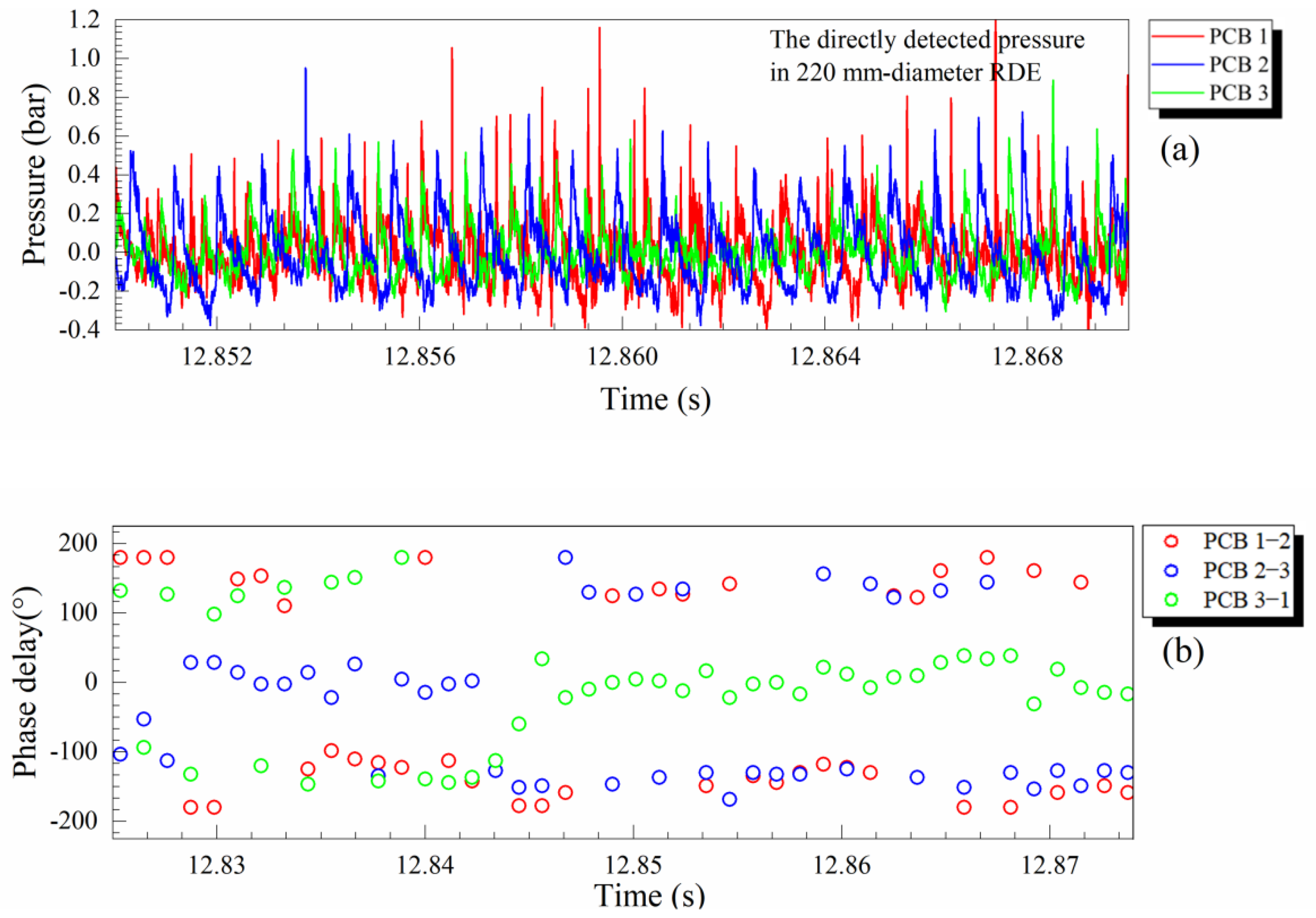
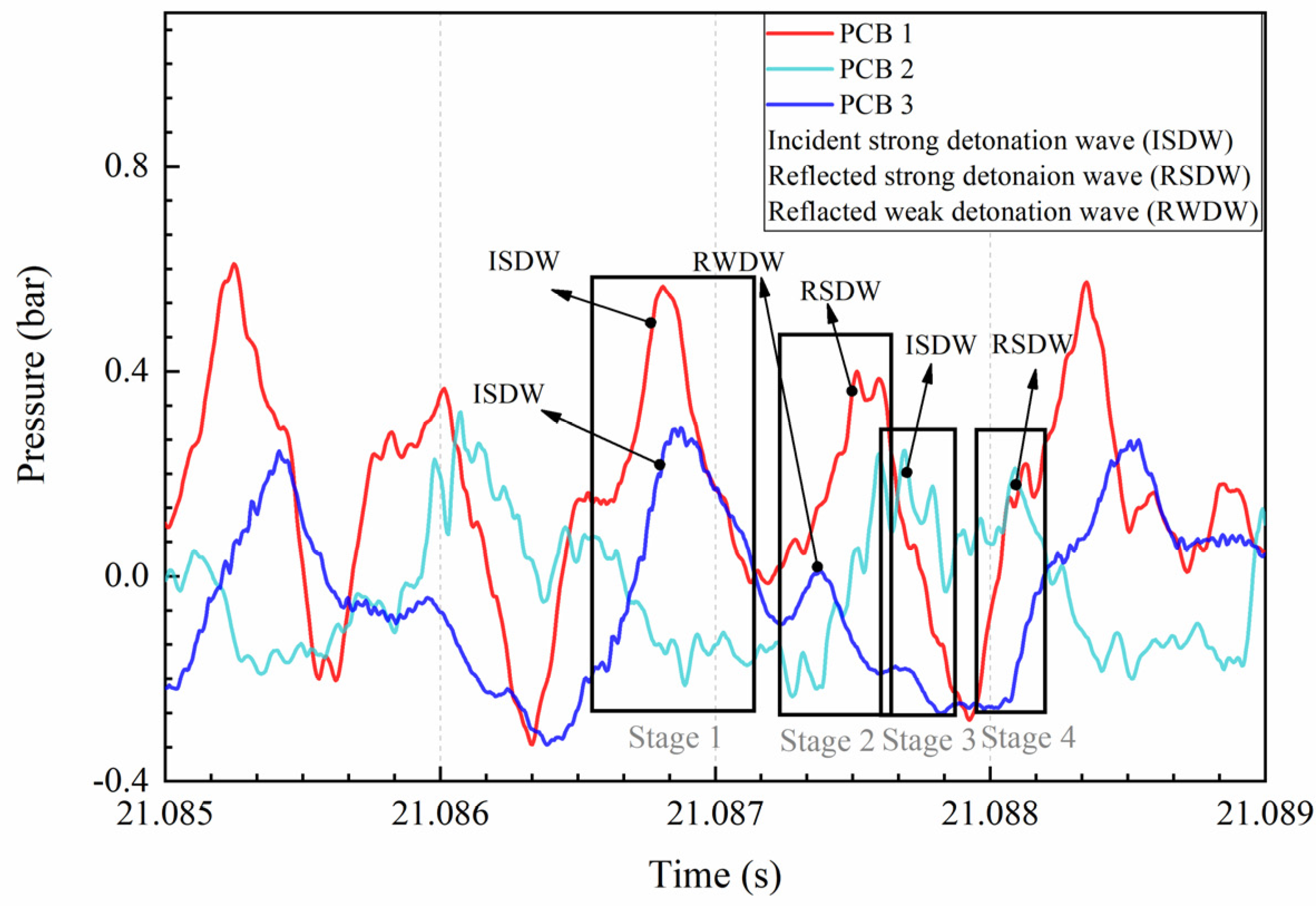
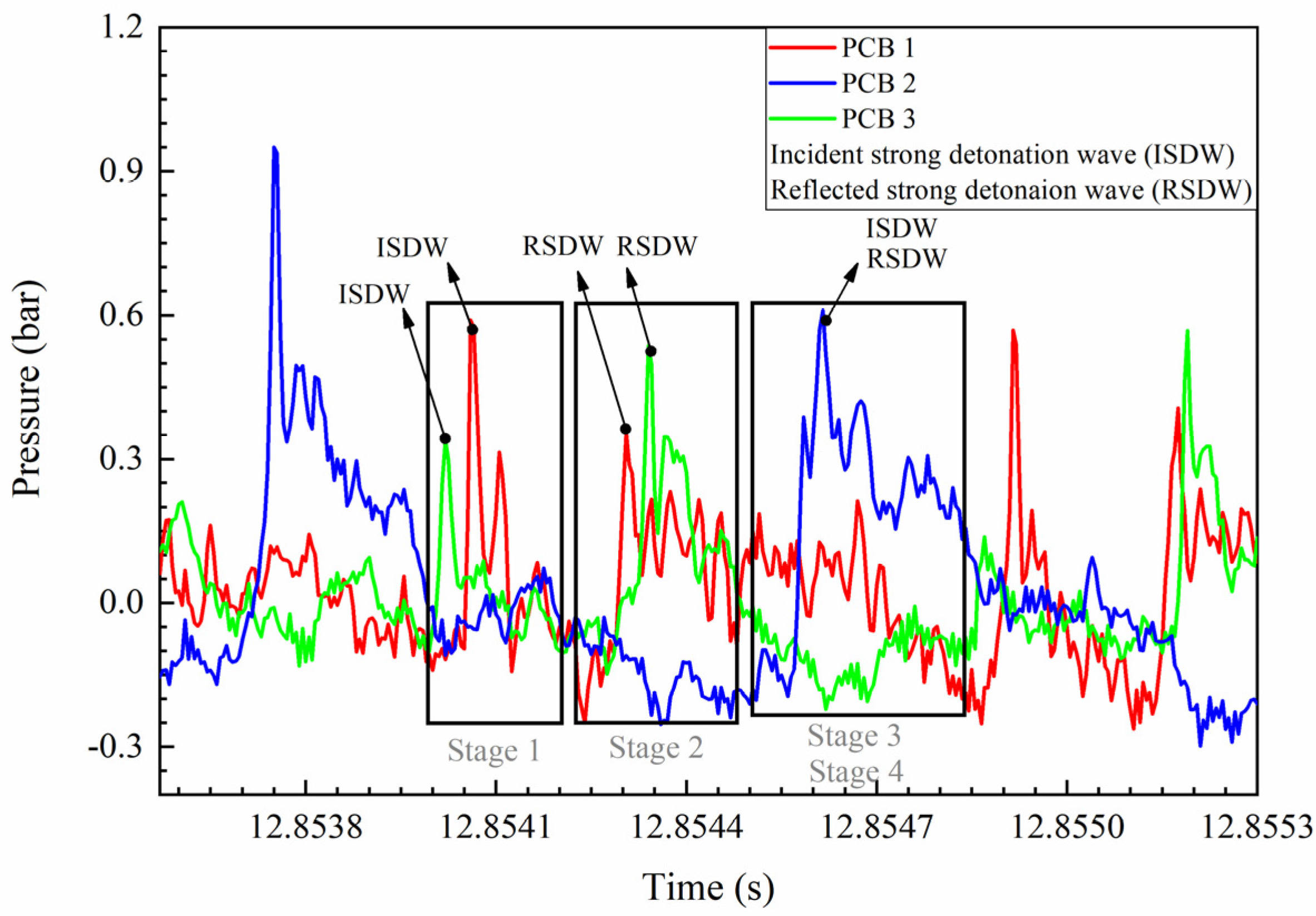



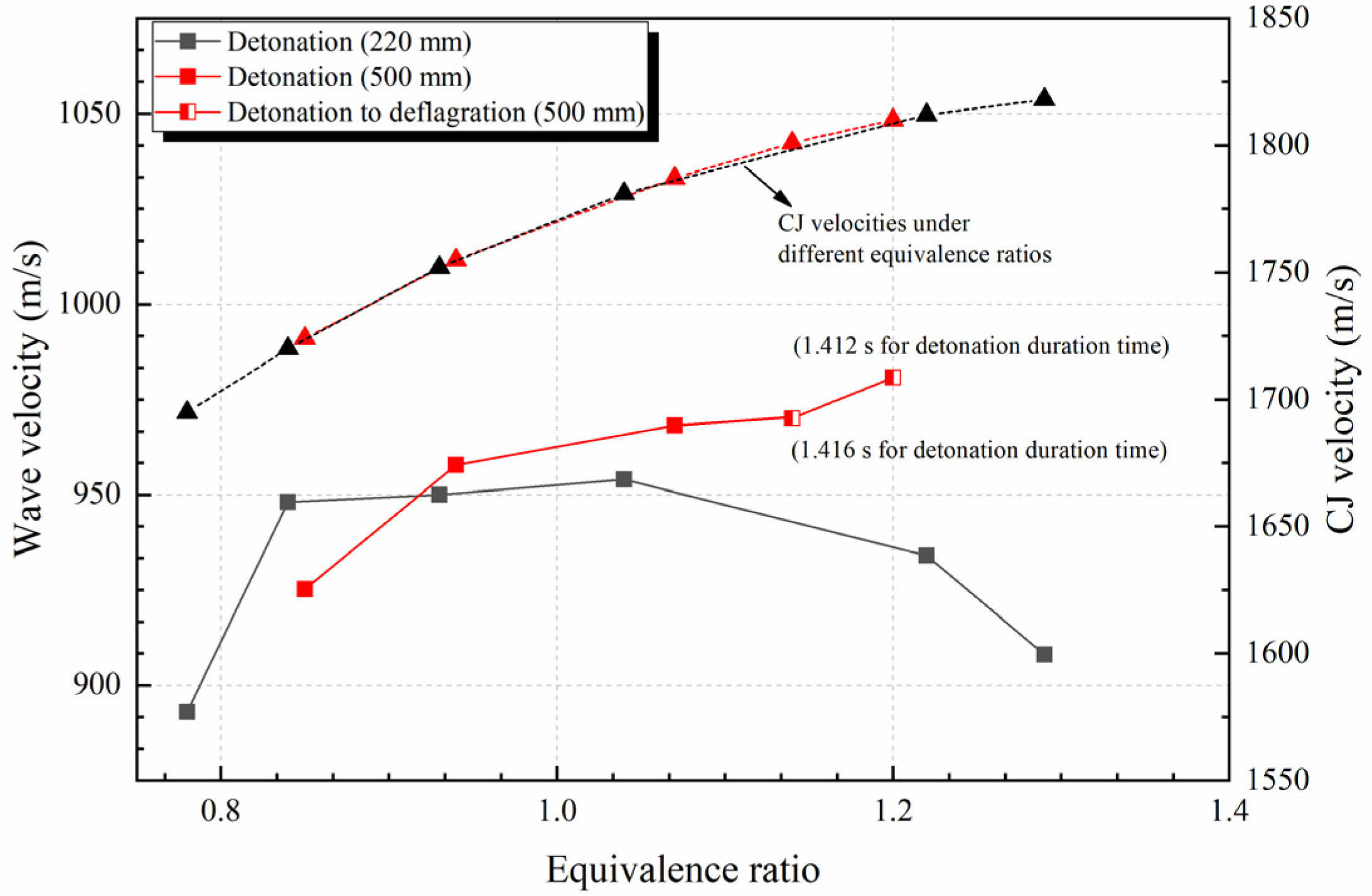
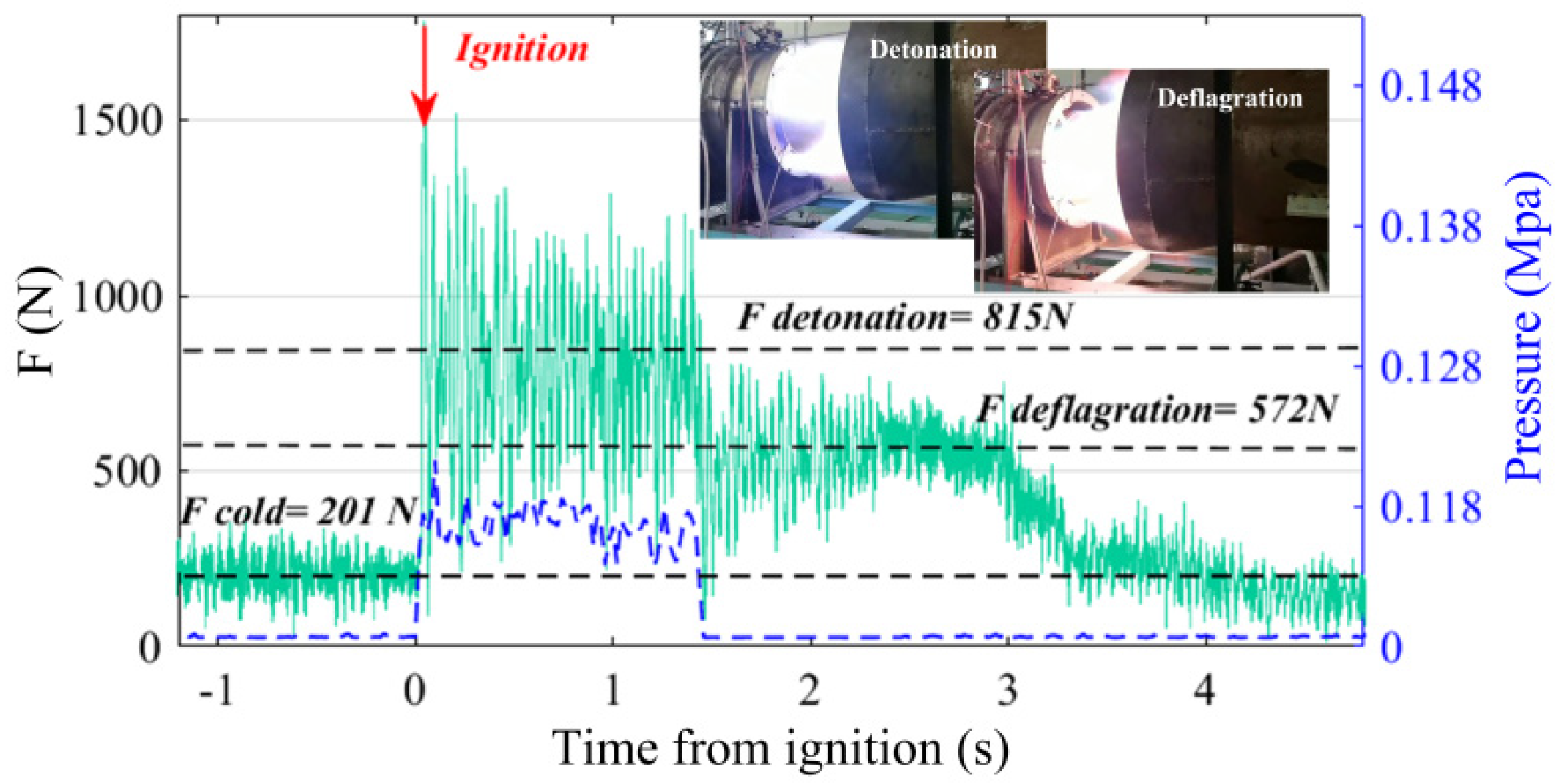
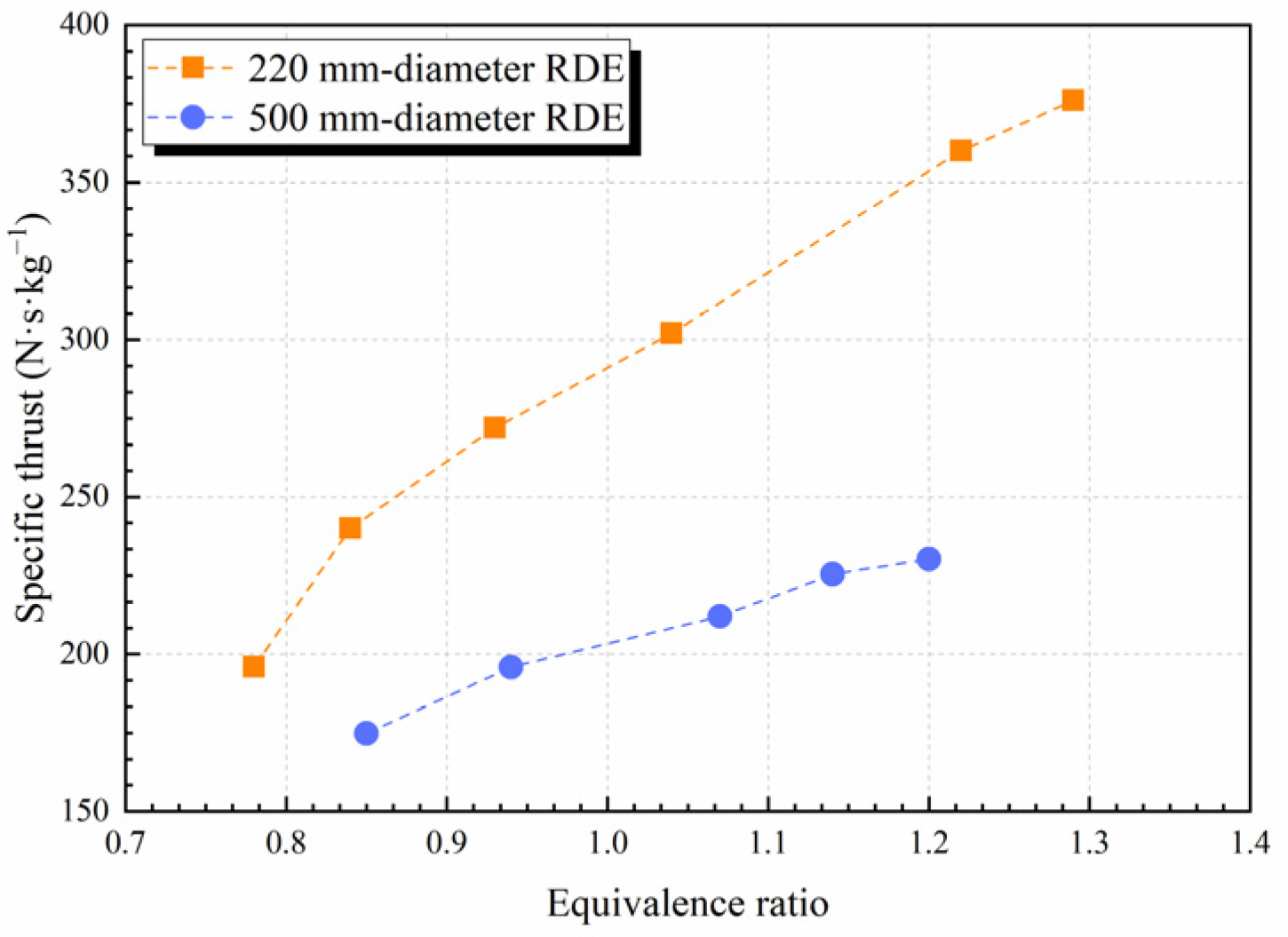

| Outer Diameter | Combustor Length | Combustor Channel Width | Throat Width | Number of Injection Holes | Interval Distance of Injection Holes | Air Flow Rate | Mass Flux in Combustor |
|---|---|---|---|---|---|---|---|
| 500 mm | 300 mm | 40 mm | 5 mm | 180 | 8.1117 mm | 2.56 kg/s | 44.31 kg/(s·m2) |
| 220 mm | 300 mm | 40 mm | 5 mm | 72 | 8.0681 mm | 1 kg/s | 44.23 kg/(s·m2) |
Publisher’s Note: MDPI stays neutral with regard to jurisdictional claims in published maps and institutional affiliations. |
© 2022 by the authors. Licensee MDPI, Basel, Switzerland. This article is an open access article distributed under the terms and conditions of the Creative Commons Attribution (CC BY) license (https://creativecommons.org/licenses/by/4.0/).
Share and Cite
Xu, S.; Song, F.; Zhou, J.; Yang, X.; Cheng, P. Experimental Study on Propagation Characteristics of Kerosene/Air RDE with Different Diameters. Energies 2022, 15, 4442. https://doi.org/10.3390/en15124442
Xu S, Song F, Zhou J, Yang X, Cheng P. Experimental Study on Propagation Characteristics of Kerosene/Air RDE with Different Diameters. Energies. 2022; 15(12):4442. https://doi.org/10.3390/en15124442
Chicago/Turabian StyleXu, Shida, Feilong Song, Jianping Zhou, Xingkui Yang, and Peng Cheng. 2022. "Experimental Study on Propagation Characteristics of Kerosene/Air RDE with Different Diameters" Energies 15, no. 12: 4442. https://doi.org/10.3390/en15124442
APA StyleXu, S., Song, F., Zhou, J., Yang, X., & Cheng, P. (2022). Experimental Study on Propagation Characteristics of Kerosene/Air RDE with Different Diameters. Energies, 15(12), 4442. https://doi.org/10.3390/en15124442






